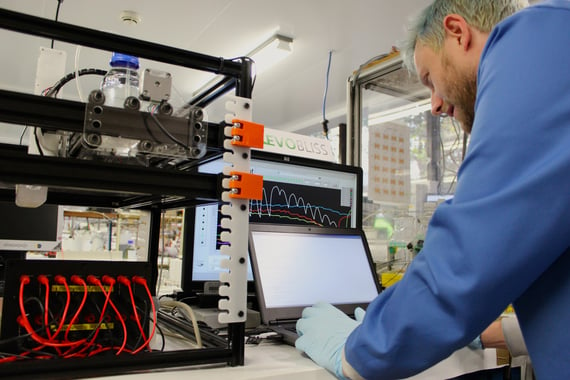Six Ways to Show Your New Robot Colleague Some Productive Love

Posted on Jul 28, 2016 7:00 AM. 5 min read time
While collaborative robots look and work somewhat differently than humans, they are also similar to their flesh and blood colleagues in many ways.
They too need care, respect and appreciation to do their best and stay healthy.
Robotiq has advised many companies on how to install collaborative robots. The immediate impact is usually a rise in effectivity – no matter the size of the company - and work satisfaction for all employees.
Alexandre Paré, application engineer at Robotiq, has worked on numerous robot installations. The experiences have taught him what it takes to make a robot perform as well as possible, as quickly as possible and for as long as possible. This, in turn, leads to the shortest and best overall return on investment.
Here are six of his recommendations for how to make your collaborative robot perform optimally.
1: Get the Robot Talking - Slowly
Programming a collaborative robot has never been easier. For many modern robots, such as the ones from Universal Robots it literally takes hours to learn how to instruct a robot how to do a task.
However, issues can arise once it comes to connecting the collaborative robot to other machines or a production management system.
Alexandre Paré advises that companies take this process slowly.
“Of course you can connect the robot to various inputs and outputs to try to get the most data out of it but is it really worth spending a lot of time trying to connect the data? Start simple, make the robot run and then once it is running start improving by connecting one signal at a time,” he says.
2: Introduce the Robot in Steps
For example, imagine a company that wants to connect a robot with a CNC machine immediately. Focusing on this right off the bat can lead to delays and confusion. It can also get in the way of the robot performing to the best of its ability.
Alexandre Paré advises to work through the following steps instead:
- Look at how and where you want to mount the robot. Will it, for example, be installed on a moving cart and capable of moving around to work on several machines? If so, the first thing to remember is to use its localization features. This ensures that moving the robot to a specific machine puts it exactly at the same spot.
- Look at the space around the robot within its reach. This area is great for stack parts that it will pick up and work on. Do not forget to account for finished parts. A chute for finished parts helps save space requirements. Extra systems and features can also help. For example, robot vision systems can help reduce the complexity of part presentation jigs.
- Start looking at programming. Write down the logic sequence / signals that you need to program the robot on a piece of paper. Regardless of approach, you need to ensure that you have a correct progression, and writing it down on paper helps. If you use logic sequence, the timing of tasks will play a big role, while a signal approach includes ins and outs from both devices (Robot and CNC) such as:
- CNC Input Signals (are also Robot Output signals):
- Robot has loaded parts
- Close/open chuck (easier to control from the robot program)
- CNC Output Signal (are also Robot input signal):
- Door open/close signal
- Machining sequence done
- CNC Input Signals (are also Robot Output signals):
Connecting the signal in the robot is straightforward. You have discrete IO signals 24VDC available in the UR controller. The CNC’s signals will vary depending on the model and manufacturer. Contact your CNC supplier to get this information.
- You should be ready to go, and to troubleshoot the final issues. The robot can now run 24/7!
3: Be Prepared to Let the Robot Fail
Most maintenance crews are used to carrying out maintenance procedures on complex automated machinery. For them, looking after collaborative robots will feel very familiar.
As with any other piece of new equipment, some early bugs and minor issues are to be expected.
“This is part of the learning curve that everyone gets through when doing their first installation. After this period, the robot may run for a while before you need to do any other tasks on it. You will see your intervention on the robot move from solving bugs to improving process operations. Soon, your maintenance crew will become experts at reducing cycle time and improving the robot’s processes,” Alexandre Paré says.
4: Leave Them Alone

This is one point where robots are opposite of humans – or even most of their machine brethren. Most robots require very little maintenance compared to complex mechanically automated machines. They do not need greasing on a regular basis and they don't really need to be re-calibrated often.
One of the biggest advantages of collaborative robots is that they can work directly alongside their human colleagues. However, this new level of interaction also comes with a caveat – the risk of accidentally knocking or bumping the robot. Luckily collaborative robots are generally quite sturdy, and recalibrating it is easy.
“If the robot hits something, the tooling can be moved around, which will require recalibration. However, with the robot you simply change the X,Y,Z values of the tooling in your robot controller. It literally takes five minutes. Doing the same on a CNC table requires calibration on all axes, which usually takes much longer,” Alexandre Paré says.
5: Make People Love Them
Few things affect robot productivity as much to managers and engineers who brought the robot into their company successfully getting operators and floor employees excited about its potential.
Some staff will be excited right away, but others might be scared that the robot is there to take their jobs. Changing this mindset will lead to staff feeling a sense of ownership over the robot and lead them to pro-actively look for other tasks for it to do.
“They will change their mind going from 'I don't want the robot to do my job' to 'I don't want to do this task anymore, why isn't the robot doing it?' This is something typical that we see when the robot is down for the first times in the production process and that the operators are back doing the process the old, manual way,” Alexandre Paré says.
6: Give Them Hard Stuff to Do

Making employees feel this way about the robot often involves giving it hard, boring things to do.
“Collaborative robots are meant to liberate humans from harsh work environments and having to repeat the same motion or tasks over and over again. I would say that from a collaborative robot's point of view, it would say to its human colleagues, ‘Hey bro, let me do this part of the task for you! It will save you time and you can focus on more exciting stuff!’,” Alexandre Paré says.
Read much more about how to get started with collaborative robots in Robotiq’s free Collaborative Robots Learning Kit (http://blog.robotiq.com/learning-kit-getting-started-with-collaborative-robots). The learning kit walks you through things like identifying how a collaborative robot makes your company more efficient and productive, how to get your workforce onboard with the robot project and how to present your case to management.










Leave a comment